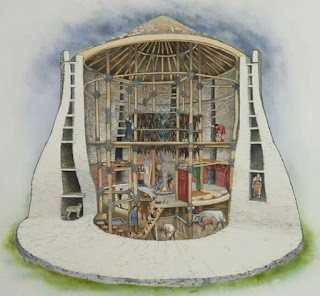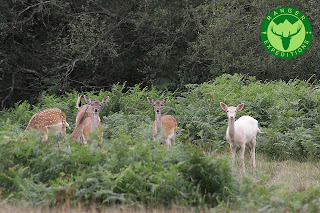AVEBURY PREHISTORIC LANDSCAPE
Six thousand years ago the rolling chalk hills of what is
now Wiltshire would have been mostly covered with forests of oak, birch and a
variety of native plant species. In the Mesolithic, a person could walk under
unbroken canopy from the south coast to the northern highlands. But with the
arrival of Neolithic farmers, came new ways of thinking, seeing and interpreting
the environment. And slowly but surely, whether by intent or otherwise, the
indigenous hunter gatherer’s way of life faded into extinction.
 |
| Avebury Stone Circle |
AVEBURY HENGE AND STONE CIRCLES
What we see now at Avebury henge and stone circles, is the
product of several hundred years (between 2850 BC and 2200BC) Neolithic and
early bronze age cosmology with several intermediate phases representing shifts
in cultural ideas, before eventually being abandoned around 1800BC.
The Avebury ring is the largest Megalithic stone circle in the world, originally comprising of about 100 stones, which in turn encloses two smaller stone circles.
The Avebury ring is the largest Megalithic stone circle in the world, originally comprising of about 100 stones, which in turn encloses two smaller stone circles.
 |
| Portion of henge ditch |
The henge survives as a huge circular bank and ditch,
encircling an area that includes part of Avebury village. The village itself
makes it difficult to visualise the expanse of the whole site, which these days
can only be fully appreciated from the air. However, in the Neolithic it is likely that the
evolution of the henge and circles began in a woodland clearing or an area
which had already been widely cleared of trees. With unbroken views across the sanctum, inside the henge.
 |
| Stones in the outer ring |
WEST KENNET AVENUE
In common with other Megalithic sites, there is a corridor
of stones connecting to the circle, the West Kennet Avenue. Next to the B4003
road, perhaps its origin was a pathway through forest, but with the felling of
the trees, the placement of the stones could have represented a more permanent
channel in the now open landscape. Which over time and repetition, may have become
more imbued with metaphysical connotations, a spiritual funnel to the gathering
and rites practiced within the banks of the henge enclosure.
 |
| West Kennet Avenue |
The Avebury sacred landscape is vast, shaped for rituals
that involved inclusion, exclusion and procession. Features which strongly
resonate in locations with the Orkney processionary route along a natural land
spit from Skara Brae, the Ring of Brodgar, Ness of Brodgar and Stones of
Stennes. Ritual pathways are also found around Stonehenge, the Cursus, Lesser
Cursus and The Avenue.
Avebury is part of an extraordinary set of Neolithic and
Bronze Age ceremonial sites that seemingly formed a vast sacred landscape. They
include West Kennet Avenue, West Kennet Long Barrow, The Sanctuary, Windmill
Hill, and the mysterious Silbury Hill.
 |
| West Kennet Avenue at Avebury Ring |
SILBURY HILL
One mile, as the crow flies, to the south of Avebury is
Silbury Hill, the largest artificial mound in Europe. Similar in height and
volume to the smaller Egyptian pyramids at the Giza Necropolis, it was
completed around 2400BC, but apparently contains no burial. Though clearly
important in itself, its purpose and significance remain unknown.
 |
| Silbury Hill |
However, the act of elevating people, whether physically,
metaphorically, or both, within a tribe or society is a familiar concept to us.
In the era of the Scandinavian sagas, the Law Speaker stood atop the Logberg
(the Law Rock) at Thingvellier and recited from memory the laws of Iceland. In
more modern times, people stepped up onto their soap boxes at speakers’ corner,
in Hyde Park. At rock concerts the performers stand upon a stage. When we think
of ritual, we tend to make associations with ancient or indigenous peoples.
 |
| Althing Parliament at Thingvellir |
However, rites of passage and tribal conventions are
everywhere in our contemporary lives. We see the elite politicians at
Parliament question time, squabbling and heckling, projecting their
self-importance in order to retain power and influence for as long as possible
with all the associated benefits, financial and otherwise. These theatrics
promote the idea that governing class is indispensable, whilst they continue to
serve their own interests first.
So, although we can only make a guess at the sort of rituals,
proclamations or subjugations made from the summit of Silbury Hill, perhaps by
tribal leaders or shamanic priests, the size of the construction certainly
effectively projected these messages to the surrounding audience and landscape.
 |
| West Kennet Long Barrow |
WEST KENNET LONG BARROW
Within sight of Sibury Hill is the West Kennet Log Barrow.
It is one of the largest, most impressive and most accessible Neolithic
chambered tombs in Britain. Built in around 3650 BC, it was used for a short
time as a burial chamber, nearly 50 people being buried here before the
chambers were blocked. It is classified by archaeologists as one of the
Cotswold-Severn class of tombs.
 |
| Entrance to West Kennet Long Barrow |
 |
| Concealed entrance viewed from above |
The tomb is on top of a natural hill. Placing the dead
nearer to the sky, perhaps an important element in an astronomical cult. In common with
other Neolithic tombs, the deceased were likely to have subject to an
excarnation process before the bones were carefully sorted and placed within
the chambers.
 |
| West Kennet main passageway |
COTSWOLD-SEVERN TOMBS
Across Western Europe, Early Neolithic pople built chambered
long barrows, rectangular or oval earthen tumuli which had a chamber built into
one end. Some of these chambers were constructed out of timber, although others
were built using large stones, now known as "megaliths". These long
barrows often served as tombs, housing the physical remains of the dead within
their chamber.
 |
| West Kennet side cell / chamber |
Individuals were rarely buried alone in the Early Neolithic,
instead being interred in collective burials with other members of their
community. These chambered tombs were built all along the Western European
seaboard during the Early Neolithic, from southeastern Spain up to southern
Sweden, taking in most of the British Isles.
 |
| West Kennet side cell / chamber |
The architectural tradition was introduced to Britain from
continental Europe in the first half of the fourth millennium BCE. Although
there are stone buildings—like Göbekli Tepe in modern Turkey—which predate
them, the chambered long barrows constitute humanity's first widespread
tradition of construction using stone. The specific design featured found in the West Kennet Longbarrow, classify it among others with similar features in the Cotswold and Severn valley area.
 |
| Entrace end of the barrow |
ARTEFACTS
Within the Alexander Keiller Museum in Avebury village is an
impressive and diverse collection of artefacts recovered from the soil. Many of
the items bring context and insights into the life of our Neolithic and Bronze
age ancestors. Red deer antlers, the tool of choice before metal, were used as
picks to quarry chalk and create the deep henge ditches.
There are some fine examples of decorated pottery, itself
part of its own cultural phase, known as the beaker culture.
Many animal bones have been found. Bovine bones in
quantities which indicate great gatherings of people and feasting. However, the
numbers of cattle killed, possibly at the behest of the elite class, may not
have necessarily been in the best interests of the population. Similar evidence
of great killings has also been uncovered in the Stonehenge area.
 |
| Red deer antler picks |
 |
| Decorated earthen ware |
 |
| Goat skeleton |
Other animal bones such as goat and dog, allude more to
domestic life and paint a picture of dwelling houses with small holdings of
arable crops, with the younger generation tasked with shepherding the smaller
animals.
Animal fat lamps extended the useful hours of the day for
creative activities, such as the decorative etching of a small piece of
chalk. With a couple of pieces of chalk
picked from a beach on the Isle of Wight, I remade these artefacts.
 |
| Neolithic lamp |
 |
| Animal fat lamp, modern museum recreation |
 |
| Neolithic decorated chalk talisman |
What I noticed, as I was etching the lines, is that the
image resembled a leaf, but then the circular feature also looked like an eye.
Archaeologists have speculated that this item may have been a talisman. With
this in mind I embellished the chalk piece with a through hole, so with the
addition of a leather lanyard or woven string, it could be used as an
adornment. In common with a earlier paleolithic lamp recreation (see #037 Paleolithic Lamp and the dawn of creativity ) I added a design on the underside: A basic labyrinth pictogram of a type from the late Neolithic - Bronze Age.
 |
| Chalk stone lamp & talisman by Stu Westfield, Nov 2019 |
 |
| Underside of chalk lamp and talisman by Stu Westfield, Nov 2019 |
The artefacts and evidence from within the Avebury prehistoric
landscape, tell us a story of highly developed and evolving cultures. A tribe,
or society of tribes, which had time and energy to devote to the sharing of
cultural ideas. People who were doing a lot more than merely surviving, but
interacting with their environment physically and spiritually in a way that
they best understood it.
 |
| Chalk stone lamp by Stu Westfield, Nov 2019 |
INSPIRED BY STONE
Our stone age crafts made in Hayfield are inspired by the human journey from paleolithic beginnings to the Viking era. Ranger Expeditions also offer challenge trekking days and discovery themed walks guided by local Mountain Leaders.










































